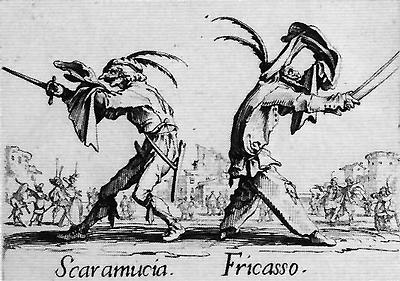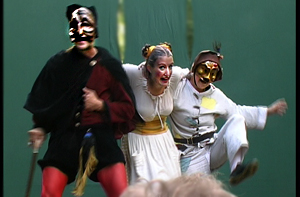When I work with Commedia dell’Arte I don’t let improvisation be the most important, even though it still is important. I do this for three reasons; Commedia dell’Arte is played from a plot, even though it is of less importance when it comes to why we play; there are very few actors with that tremendous improvisation skills; the fixed elements – the acrobatics, the music, battute, concetti, all forms of disciplines, lazzi – is what I find most interesting in Commedia dell’Arte.
One more thing that makes Commedia dell’Arte is rhythm. We can look at Commedia dell’Arte as a musical representation. Every scene in a performance, every mask all the way down to every gesture or line is sat within a rhythm. It is important to let the audience breath with the performance. This rhythm is what builds up the show to a musical performance. There are rhythm, crescendos and pauses in breathing; therefore it is vital that the actor first listen to the rhythm of the performance before he starts to improvise.
I always start up by creating highly firm scenery, most of the time we are even working from a written script. This gives the actor the security he needs to be able to come back to the rhythm at any time in the play. The actor also learns when not to improvise. The more the actor has to fall back on the more free he can be in his improvisations, without risking to ruin the rhythm of the performance.
It is when we are getting closer to the opening of a play, having all the firmly fixed sceneries in the actor’s backbone, that we start to fly, in other words we let the improvisations free. This is where we start to use test audiences in order to be sure the play is constantly aimed to it, listening to it and improvising to it by reacting to it. We also start to put ”monkey spanners in the works” in order to force the actors to start improvising so the acting won’t get too static
Kategorier
Arkiv
- november 2023
- maj 2023
- september 2022
- december 2021
- november 2021
- oktober 2021
- september 2021
- maj 2021
- april 2021
- mars 2021
- februari 2021
- januari 2021
- december 2020
- november 2020
- oktober 2020
- juni 2020
- maj 2020
- april 2020
- mars 2020
- maj 2017
- april 2017
- mars 2017
- februari 2017
- januari 2017
- december 2016
- november 2016
- oktober 2016
- september 2016
- juni 2016
- maj 2016
- april 2016
- mars 2016
- februari 2016
- januari 2016
- december 2015
- november 2015
- oktober 2014
- september 2014
- maj 2014
- december 2013
- november 2013
- mars 2013
- februari 2013
- januari 2013
- december 2012
- november 2012
- september 2012
- april 2012
- mars 2012
- februari 2012
- januari 2012
- december 2011
- november 2011
- oktober 2011
- juli 2011
Links
- Antonio Fava
- Burnt Out Punks
- Commedia dell'Arte day
- Dell'Arte International School of Physical Theatre
- Drama and Theatre Resource Guide
- École de Théâtre Jacques Lecoq
- Ecole Phillippe Gaulier
- Edinburgh Festival
- Glossa Teatro
- Jokes from 1906 to 2015
- Justin’s Theatre Links
- La Mama
- Marco Luly
- Maskmakers web
- Mummenschanz
- Teater Moment
- Teater Slava
- Theatret Thalias Tjenare
- Yahoo's Commedia dell'Arte group

Pingback: Improvisation in Commedia dell’Arte (Part 3) |
Pingback: Improvisation in Commedia dell’Arte (Part 1) |